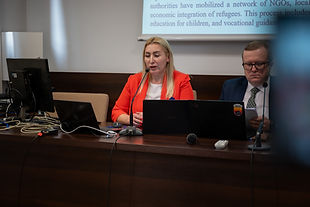
EXPERTISE

Prof. Ewa Tuora-Schwirskott
Collegium Witelona Uczelnia Państwowa w Legnicy
Policy Towards Migrants from Ukraine in German-speaking Countries
The outbreak of the Russo-Ukrainian war spurred an exodus of people from Ukraine to European Union member states, including German-speaking countries. Currently, in Germany stay around 1.1 million people who have entered since 24 February 2022 following the Russian war of aggression against Ukraine. Of those, about 350,000 are children and adolescents under 18 years of age. About two thirds of adult migrants are women.
In Switzerland, there are currently around 67,000 Ukrainian citizens who have been granted refugee status, i.e. "S" status or "S" visa. Austria has seen an inflow of 52,803 people from Ukraine following the outbreak of the war. Those who had come to Austria earlier combined, approximately 81,000 Ukrainian citizens currently stay in Austria. More than two thirds (69.4%) of the Ukrainian population in Austria are women, and only 31.6% are men. Only 10% of Ukrainian citizens are over 60 years old.
According to the Federal Employment Agency, there are currently around 725,000 Ukrainian citizens in Germany who are of working age, which the Federal Employment Agency interprets as people aged between 15 and 65 years of age. In November 2023, 21% of those had employment: 113,000 were employed with social security contributions paid in Germany, and 36,000 had "mini-jobs", i.e. income-limited employment. Noteworthy, the level of employment of Ukrainian citizens on the German labour market is considered as one of the failures of the migration policy pursued by the German government, which in this matter looks with envy at the Polish labour market and the Polish legislator. Despite the now difficult economic situation, the German government hopes that more people who left Ukraine because of Russia's aggression would still be willing to take up employment. The low employment rate of Ukrainian citizens is due to the lack of recognition of professional qualifications obtained in Ukraine on the German market, and to the German policy of requiring integration courses to be completed before taking up a job.
A study by the Austrian Integration Fund (Österreichischer Integrationsfond, ÖIF) shows that 42.5% of surveyed women are currently employed on the labour market, which marks a significant progress as in 2023 the rate was 25% and in 2022 only about 10%. According to the Österreichischer Integrationsfond, these high rates are due to the level of education of the migrants: three quarters of those surveyed have higher education. However, the study results are ambiguous, as another study by the Austrian Labour Market Research Agency (Arbeitsmarkdaten und Arbeitsmarktforschung) shows that 54.9% of men and 64.6% of women were not looking for a job at the time of the survey. Two thirds of the survey participants described their income situation as very uncertain. The main reason given is that only part-time work is available, and only in unskilled job positions. Employment beneath the education level and professional qualifications of a migrant is a huge problem in migration policy.
In Switzerland, according to the latest data from the State Secretariat for Migration (Staatssekretariats für Migration, SEM), there are approximately 66,000 Ukrainian citizens registered in Switzerland, of whom 40,000 are of working age. The employment rate is reported at 20%, which is low compared to the Swiss average of 70%. Ukrainian citizens staying in Switzerland are also characterized by a high level of education; according to the data of the Swiss Statistical Office, two thirds of Ukrainian refugees in Switzerland have higher education, and 92% have a secondary school diploma.
Read more:
See more expert opinions
Katolicki Uniwersytet Lubelski Jana Pawła II
The task is financed by the Minister











